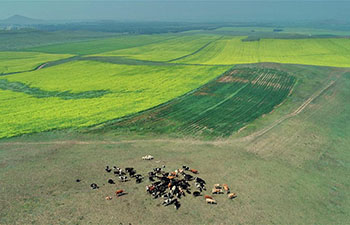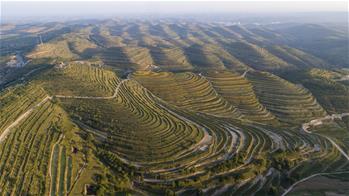BEIJING, July 30 (Xinhua) -- Pandas are an incredibly common sight in today's world. From scenes of awestruck children at panda zoo enclosures to the craze surrounding Hollywood blockbuster Kung-Fu Panda, and to countless viral videos of the black and white bear playing, napping and sneezing in nature reserves, "pandamania" has gone far beyond China's borders and captured the hearts of people all over the world.
It is hard to imagine that just over 150 years ago, this beloved bear was only known to a handful of villagers. But despite the immense human obsession with this cuddly creature, do we really know much about it? What is its backstory?
Famous for its spicy cuisines, Buddha cliffs and iconic landscapes of mist-shrouded mountain tops, Sichuan Province in southwest China is often dubbed the "giant panda capital of the world."
Beyond the bustling provincial capital city of Chengdu lie acres of lush greenery and desolate canyons. More than a century and a half ago, this bamboo paradise held some of nature's best-kept secrets, but not for much longer.
In 1862 the French priest, zoologist and botanist Armand David was posted to China to identify and collect unknown plant and animal species for the National Museum of Natural History in Paris.
When he ventured out to Sichuan, he was in for a massive surprise.
While scouting Dengchigou Village in Baoxing County on March 11, 1869, David stumbled across the house of a villager named Li Pinshan. Xinhua visited Li's grandson, Li Wantao, who explained what happened on that historic day 150 years ago.
Li told us that when David came across his grandfather's home, he saw a black and white animal skin and thought it was "very peculiar."
Driven by his curiosity to find out where this strange fur had come from, David hired hunters to scout the mountains of Baoxing and bring him the animal in the flesh.
On April 1, 1869, three weeks after finding his initial clue, David finally laid his eyes on a live "black and white bear." A moment believed to have marked the first time a Westerner encountered a panda.
In a letter he sent to the museum in Paris, David told them he had found something special and proposed the Latin name "Ursus melanoleucus" for the animal -- literally meaning "black and white bear."
He also described its unusual markings and appearance and wrote: "I have not seen this species in the museums of Europe, and it is easily the prettiest I have come across; perhaps it will turn out to be new to science!"
David then attempted to send the "black and white bear" to Paris. However, it died on the way.
Nevertheless, he sent it as a specimen to the museum in Paris. There, his zoological contact Alphonse Milne-Edwards examined its skin and skeleton and later published a paper in 1870 declaring it a new species.
The zoologist gave the unique bear its scientific name as "Ailuropoda melanoleuca" and set the "pandamania" bandwagon in motion.
Due to its significant history, Baoxing is often called the "hometown of the giant panda." A total of 181 wild giant pandas currently live in the county's boundless forests.
Every now and then, villagers spot giant pandas walking along roads, sleeping on trees, and even making uninvited visits to their homes. One villager, named Li Jun, told Xinhua that wild pandas had visited his house three times.
But the giant panda's fascinating history can be traced much further back than the 1800s.
Once upon a time, the now-famous bear was widespread throughout China as well as neighboring Myanmar and Vietnam.
But human threats like poaching, deforestation and climate change, as well as natural disasters have created a cocktail for disaster, pushing the species to the brink of extinction.
The giant panda also has a short fertility period and is unable to digest the majority of the bamboo it consumes, which explains why they are sometimes called an "evolutionary enigma."
Aware of panda's dangerous situation, China began implementing measures to protect and restore habitats, as well as expand and build nature reserves and breeding bases, in a race to save the bear.
Efforts have paid off. According to data released in 2015, there were 1,864 giant pandas living in the wild, up from 1,114 in the 1980s.
A year later in 2016, the status of the giant panda was downgraded from "endangered" to "vulnerable" on the IUCN Red List of Threatened Species.
But the protection efforts have not stopped. Researchers have been helping pandas that were bred in captivity return back to nature, while a 27,000-square-kilometer Giant Panda National Park, three times the area of America's Yellowstone National Park, is now being built.
Xinhua spoke to various foreign tourists at the Dujiangyan Panda Base in Sichuan, who expressed their admiration for the giant panda, describing it as "the doctor of the heart," "representative of the Chinese people" and "a species that shows the importance of protecting endangered animals."
From hidden species to an icon of China, from critically endangered to face of global wildlife conservation, from hunter's prey to A-list celebrity, the treasured giant panda has had one heck of a history.
As for its future, however, it will no doubt continue to inspire science and bring joy to panda lovers across the globe. But most importantly, it will continue to survive.

















